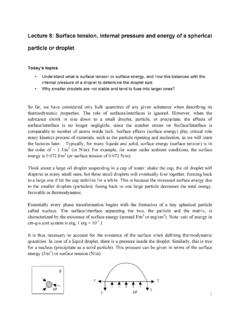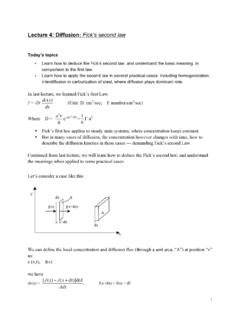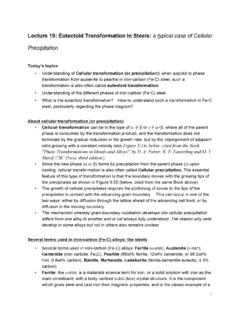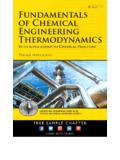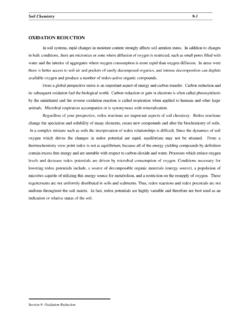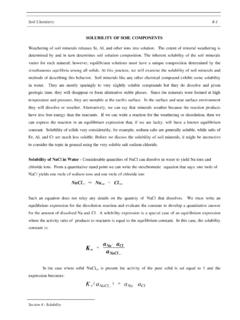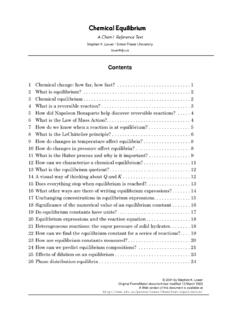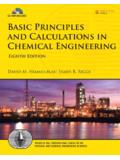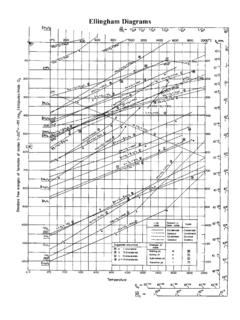Transcription of Lecture 1: Kinetics vs. Thermodynamics: different but related
1 Lecture 1: Kinetics vs. thermodynamics : different but related Today's topics The basic concepts of Kinetics and thermodynamics , and how to understand the difference and inter-relationship between the two when applied to chemical reactions or materials transformations. In a materials- related process, like chemical reaction, what determines the rate (or Kinetics )? Some basic parameters to understand for the Kinetics : transition state, driving force, activation energy. thermodynamics : all about if . tells whether or not a process or a reaction can occur (is there a decrease in free energy?). applicable to systems in stable or metastable equilibrium sufficient driving force is needed to enforce a favorable transformation,. Kinetics : all about how . how fast or slow a process can occur, , determining the rate applicable to systems in transition from nonequilibrium to equilibrium, or between two equilibrium states Kinetics of a process is generally about how to overcome the energy barrier to finish the transformation from the starting (reactant) state to the final (product) state.
2 A process concerned for Kinetics could be a chemical reaction (change between different molecules or materials), or a transformation between two material structures (or phases), for which only the crystalline structure (atomic arrangement) changes, while the chemical compositions (concerned elements, ionic valence state, etc) remain the same. Indeed, such phase transformation will be one of the major topic throughout this Kinetics course. Typical examples of phase transformation include freezing of water, eutectoid transformation of steel between austenite ( -Fe) and pearlite ( -Fe + Fe3C), transition between graphite and diamond (but takes forever), etc. In all processes of materials transformation, atomic (ionic) rearrangement takes place. When an atom (ion) moves in an environment surrounded by other atoms or ions, bonds are broken, new bonds are formed and the surrounding atoms are displaced (during the transition) from their equilibrium positions.
3 This leads to a momentary increase in local energy, forming an intermediate (non-equilibrium) state, so-called transition (or activated) state. Thus, two equilibrium states which are characterized by local minima in free energy (G, stands for Gibbs free energy) are separated by a maximum represented by the activated state, as shown below: 1. G. Ga G1. G. G2. initial state activated state final state The local minima are state function, and intrinsic to the molecular (materials) structure, where inter-atomic interaction plays important role in determining the system energy. The energy-minimized state can usually be calculated by theoretical and computational methods. However, this is not true for the maximum (activated state), for which the structure is not in equilibrium and hard to predict. For a process to occur, it must overcome the energy maximum.
4 The larger the barrier ( Ga), the difference between the maximum and the initial minimum, the harder the process to occur, the slower the rate. For a process or a reaction to occur, the thermodynamics must be favorable ( , G < 0), and the Kinetics must be fast enough (small Ga). In general: Rate (Kinetic factor) (Thermodynamic factor). Kinetic factor refers to Ga, activation energy; while the thermodynamic factor refers to G. =G2-G1, the driving force. Understanding of G =G2-G1, the driving force A thermodynamically favorable reaction or process means G < 0, that's to say, highly driven! -- the products are at a lower free energy, or more stable, than the reactants. Because of this, the reactants "want" to be converted into the products. Understanding of Ga, activation energy It is the maximum in energy separating the two equilibrium states; overcoming this barrier represents the bottle-neck for the reaction to finish, thus a rate determining step.
5 The rate can be given in terms of the transition state (often called activated complex) by considering the activation energy, Ga. The high hump of activation energy also indicates the high energy of the transition state, or activated complex, that is at the top of the hump is so unstable. 2. It is often gets confused between thermodynamic quantities like free energy with kinetic ones like activation energy. Probably for this reason, thermodynamics and Kinetics are often taught in separate courses as in our department. The free energies are average energies over a large number of atoms. As a result of random thermal motion of the atoms (depending on temperature), the energy of any particular atom will vary with time and occasionally it may be sufficient for the atom to reach the activated state, which is called thermal activation.
6 Kinetic theory: the rate of reaction is proportional to the probability to reach activated state, thus, rate e- G. a /KT. --- This is Arrhenius rate equation: dependence on temperature. Rewrite the rate in logarithm, Ln(Rate) ( Ga/R) 1/T, giving linear relationship with slope indicative of the activation energy, as evidenced in numerous real cases of chemical reactions or materials processing. For example: For diamond growth via CVD from reaction of methane and hydrogen (from the CVD Diamond Lab, the School of Chemistry, University of Bristol, UK), the growth rate (as defined in thickness). gradually increases with temperature as shown below. Re-plot the data in logarithm, giving linear dependence as expected, where with the slope the activation energy, Ga, can be calculated. 3. Basically, the higher the temperature, the stronger the mobility of atoms/molecules, and thus the more chance (probability) for them to overcome the energy barrier, as a result, the faster the rate of a reaction or process.
7 --- one way to speed up the reaction is heating it up. The other way to speed up the reaction is to use catalyst, to lower down the energy barrier, , decreasing the activation energy, Ga. For example, 1. In the Haber process, finely divided iron serves as a catalyst for the synthesis of ammonia from nitrogen and hydrogen, whereas such reaction can hardly occur without catalysts due to the high activation energy. 2. Petroleum refining makes intensive use of catalysis for alkylation, catalytic cracking (breaking long-chain hydrocarbons into smaller pieces), naphtha reforming and steam reforming (conversion of hydrocarbons into synthesis gas). 3. Another example is catalytic converter , typically composed of platinum and rhodium, working as a catalyst to convert the toxic by-products of combustion less-toxic substances, such as 2CO + 2NO 2CO2 + N2.
8 4. Significance of catalysis: 90% of all commercially produced chemical products involve catalysts at some stage in the process of their manufacture (R&D Magazine, September 2005, pg 20). In 2005, catalytic processes generated about $900 billion in products worldwide. To further understand the thermodynamics vs. Kinetics See many examples of change or transformation that are Thermodynamically favorable but kinetically unfavorable graphite and diamond are both forms of carbon, but graphite has a lower free energy. Therefore, diamond is thermodynamically favorable to convert into graphite. However, this will never happen within your lifetime --- it is always safe on your finger! For the diamond graphite transformation, getting to the transition state probably involves, among other things, breaking all the carbon-carbon bonds in diamond.
9 Breaking those bonds demands huge amount of energy, implying high activation energy. Graphite Diamond Another example is the reaction between hydrogen and oxygen, which is a highly favorable exothermic reaction. However, the reaction won't start spontaneously by itself unless ignited by a spark (explosive! Never try it without professional guidance and facility). Indeed, mixture of hydrogen and oxygen remains stable at room temperature. Ignition like burning causes the reaction lasting, producing water, where the heat (flame). thus produced in turn to activate the reaction. One more example is for some metastable states (materials) like glass, which is formed by a supercooling process and remains in the metastable amorphous state against the more thermodynamically stable state of crystal (quartz). For this metastable glass state, its transition (if it can be made to occur) to the crystalline state may be regarded as a transition from one thermodynamic (abeit metastable) state to another thermodynamic (more stable) state.
10 However, such a transition process is so slow (sluggish) that the process or reaction does not occur during the course of observation, , the system remains in the metastable state indefinitely. --- the transport of ions or atoms at low temperature (for example room temperature) is so slow that glass continues to exist in an amorphous state at room temperature indefinitely. 5. In brief summary: thermodynamics tells us that a reaction should go if the products are more stable (have a lower free energy) than the reactants --- the reaction has a negative free energy change. Kinetics , on the other hand, tells us how fast the reaction will go, though doesn't tell us anything about the final state of things once it gets there. thermodynamics is not about dynamics at all, it is not about moving and changing; it has nothing to do with time.
